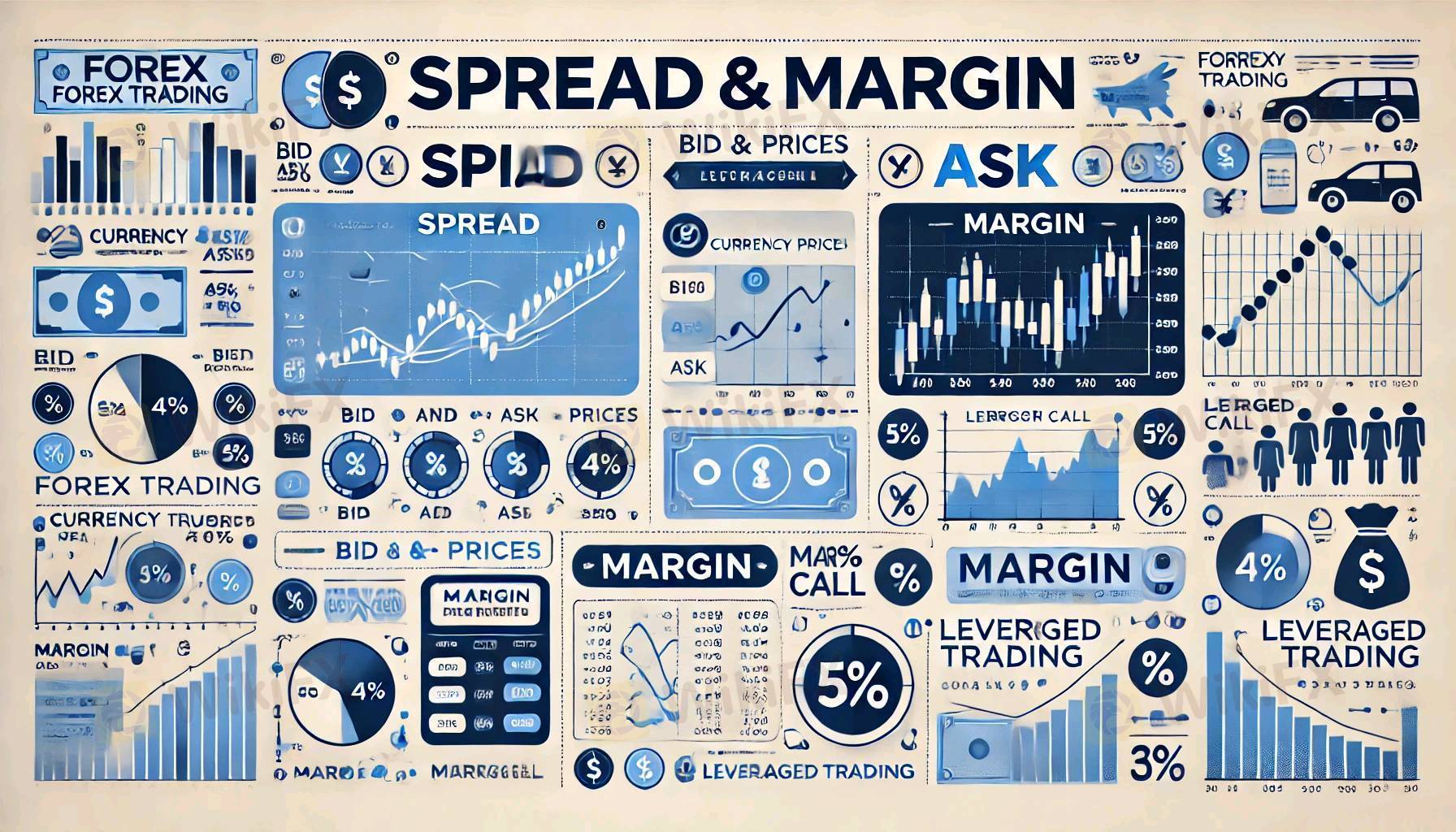
2025-01-29 21:22
IndustriSpread and Margin in forex trading
#firstdealofthenewyearAKEEL
Spread and Margin in Forex Trading
1. What is Spread?
In forex trading, the spread is the difference between the bid price (the price at which you can sell a currency pair) and the ask price (the price at which you can buy a currency pair).
The spread is effectively the cost of executing a trade and represents the broker's profit for facilitating the transaction.
Bid Price: The price a broker is willing to pay for a currency pair.
Ask Price: The price a broker is willing to sell a currency pair.
Spread Formula:
\text{Spread} = \text{Ask Price} - \text{Bid Price}
Example:
If the EUR/USD bid price is 1.1230 and the ask price is 1.1233:
Spread = 1.1233 - 1.1230 = 0.0003 (3 pips).
Types of Spreads:
1. Fixed Spread:
Remains constant regardless of market conditions.
Suitable for traders seeking predictable costs.
2. Variable Spread:
Fluctuates based on market conditions, such as volatility or liquidity.
Often narrower during stable periods and wider during volatile events.
2. What is Margin?
Margin in forex trading is the amount of money a trader needs to deposit to open and maintain a leveraged trading position. It acts as collateral for the broker.
Margin is directly related to leverage, which allows traders to control larger positions than their initial investment.
Key Terms in Margin Trading:
Margin Requirement: The percentage of the total trade value that must be deposited.
Used Margin: The amount allocated to open active trades.
Free Margin: The remaining funds available to open new trades or absorb losses.
Margin Call: A broker's notification that your account equity has dropped below the required margin level.
Margin Formula:
\text{Margin Requirement} = \frac{\text{Trade Size}}{\text{Leverage}}
Example:
Trade Size: $100,000 (1 standard lot)
Leverage: 100:1
Margin Requirement: $100,000 ÷ 100 = $1,000
3. Key Differences Between Spread and Margin
4. Relationship Between Spread and Margin
Spread: Directly impacts the cost of trading, particularly for frequent or short-term trades.
Margin: Allows traders to control larger positions, but misuse of leverage can amplify losses.
Understanding both concepts is crucial for managing trading costs and risk effectively.
#firstdealofthenewyearAKEEL
Suka 0
Khaleefamb1
Trader
Diskusi populer
Industri
СЕКРЕТ ЖЕНСКОГО ФОРЕКСА
Industri
УКРАИНА СОБИРАЕТСЯ СТАТЬ ЛИДЕРОМ НА РЫНКЕ NFT
Industri
Alasan Investasi Bodong Tumbuh Subur di Indonesia
Industri
Forex Eropa EURUSD 29 Maret: Berusaha Naik dari Terendah 4 Bulan
Analisis pasar
Bursa Asia Kebakaran, Eh... IHSG Ikut-ikutan
Analisis pasar
Kinerja BUMN Karya Disinggung Dahlan Iskan, Sahamnya Pada Rontok
Klasifikasi pasar

Platform

Pameran

Agen

Perekrutan

EA

Industri

Pasar

Indeks
Spread and Margin in forex trading
 Nigeria | 2025-01-29 21:22
Nigeria | 2025-01-29 21:22#firstdealofthenewyearAKEEL
Spread and Margin in Forex Trading
1. What is Spread?
In forex trading, the spread is the difference between the bid price (the price at which you can sell a currency pair) and the ask price (the price at which you can buy a currency pair).
The spread is effectively the cost of executing a trade and represents the broker's profit for facilitating the transaction.
Bid Price: The price a broker is willing to pay for a currency pair.
Ask Price: The price a broker is willing to sell a currency pair.
Spread Formula:
\text{Spread} = \text{Ask Price} - \text{Bid Price}
Example:
If the EUR/USD bid price is 1.1230 and the ask price is 1.1233:
Spread = 1.1233 - 1.1230 = 0.0003 (3 pips).
Types of Spreads:
1. Fixed Spread:
Remains constant regardless of market conditions.
Suitable for traders seeking predictable costs.
2. Variable Spread:
Fluctuates based on market conditions, such as volatility or liquidity.
Often narrower during stable periods and wider during volatile events.
2. What is Margin?
Margin in forex trading is the amount of money a trader needs to deposit to open and maintain a leveraged trading position. It acts as collateral for the broker.
Margin is directly related to leverage, which allows traders to control larger positions than their initial investment.
Key Terms in Margin Trading:
Margin Requirement: The percentage of the total trade value that must be deposited.
Used Margin: The amount allocated to open active trades.
Free Margin: The remaining funds available to open new trades or absorb losses.
Margin Call: A broker's notification that your account equity has dropped below the required margin level.
Margin Formula:
\text{Margin Requirement} = \frac{\text{Trade Size}}{\text{Leverage}}
Example:
Trade Size: $100,000 (1 standard lot)
Leverage: 100:1
Margin Requirement: $100,000 ÷ 100 = $1,000
3. Key Differences Between Spread and Margin
4. Relationship Between Spread and Margin
Spread: Directly impacts the cost of trading, particularly for frequent or short-term trades.
Margin: Allows traders to control larger positions, but misuse of leverage can amplify losses.
Understanding both concepts is crucial for managing trading costs and risk effectively.
#firstdealofthenewyearAKEEL
Suka 0
Saya juga ingin komentar
Tanyakan pertanyaan
0Komentar

Belum ada yang berkomentar, segera jadi yang pertama

Tanyakan pertanyaan
Belum ada yang berkomentar, segera jadi yang pertama